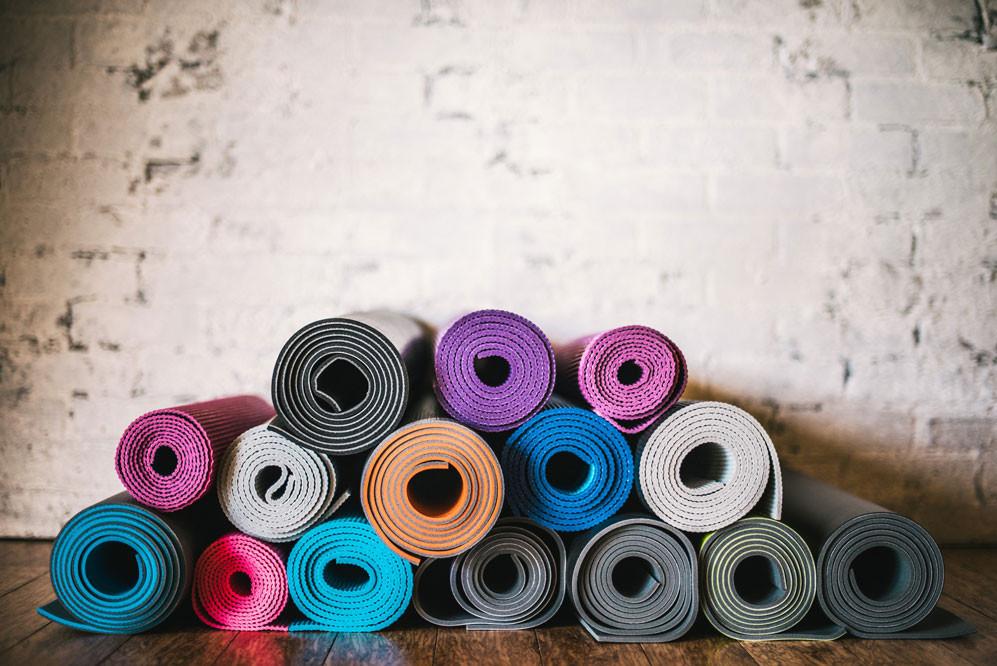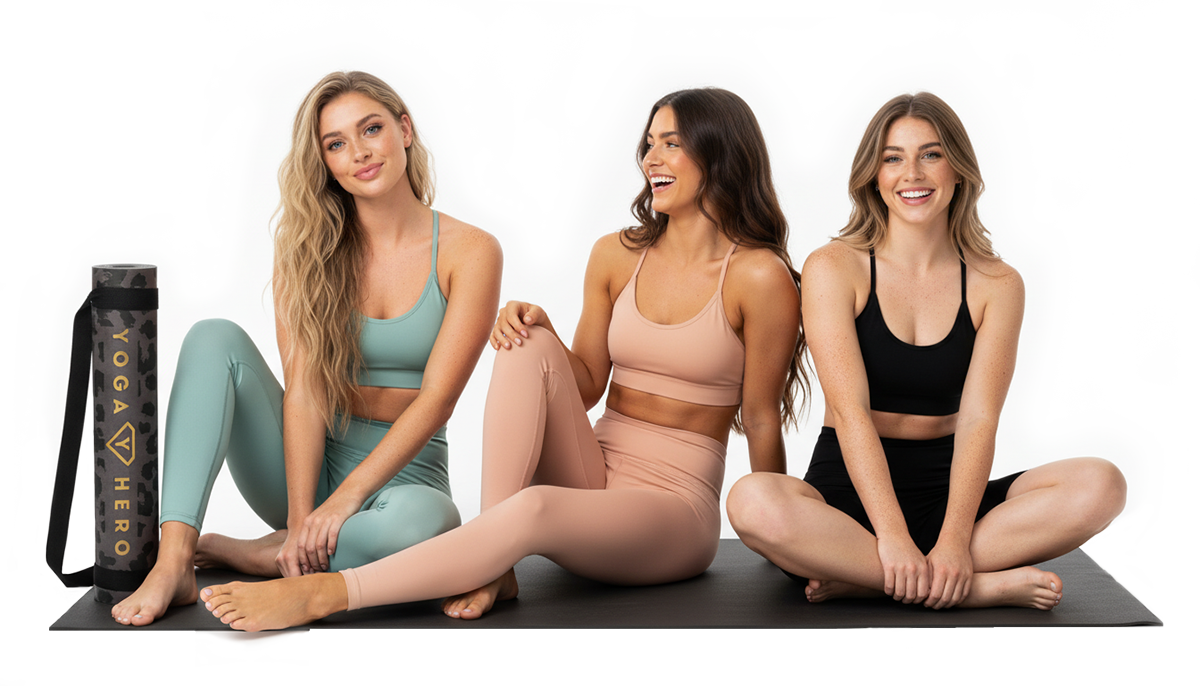
The right yoga mat can make a huge difference in your yoga practice, and to make that mat last it’s important to care for it well. If you are using a mat frequently and for many different types of yoga session it may even be worth the investment to get a few that fit all of your needs. Out door sessions can often require a thicker mat, while hot yoga will require a mat with a textured surface for easier grip and a yoga blanket or towel to keep the surface dry and safe throughout the class. It can be easy to care for your yoga mat, taking only minutes every use, and it doesn’t require a large investment in cleaning supplies or other products, a simple yoga mat cleaner or alternative and a gently cloth are all that is really necessary. Your mat should be cleaned after each use, rolled gently for storage and transport, and carried to and from class covered or in a manner to keep it from direct contact with dirt and debris, and should be stored away from areas that will have spills but easy to reach. By taking just a few steps and precautions your yoga mat can last years, even with a daily practice.
To protect your yoga mat a towel or blanket can but used during practice. This helps to keep the amount of sweat and bacteria that come in direct contact with the mat, which makes it both easier to clean and protect the surface. When practicing hot yoga or a strenuous yoga flow it can be quiet beneficial to use a towel or blanket, not only to help with poses, to help the feet and hands be less susceptible to slip on the mat, and will also keep the mat dry and prevent damage that can occur from the mat becoming damp. Sweat also carries bacteria, and by protecting your mat from that bacteria you can lengthen the life of your mat.
As bacteria multiple when left in place it is necessary to maintain the cleanliness of your mat by wiping it down after each use. There are many mat cleaners that can be used, with multiple price points and ingredients ensuring there is one that everyone can find the right mat for themselves. Many of these cleaners are now made with essential oils, which can be beneficial for sanitizing and disinfecting, but it may also affect the material that the mat is made from and cause it to show wear sooner then other cleaners. When no mat cleaner is available a diluted vinegar spray can be use in it’s place. To clean your mat mist a light spray of cleanser over the mat and wipe it with a soft cloth or towel. Each cleaner will have it’s own set of instructions for use that can be followed, and some cleaners may be better suited to some mat materials and cleaning needs then others. Something that is antibacterial is best, as it will cut down both the damage that can be caused to the mat and also ensure your mat smells fresh and ready to go. Allowing sweat, dirt, and bacteria to remain on a mat after use will lead to a mildew or musty smell, or one similar to gym socks, but a mat cleaner can take care of all the build up, avoid mildew or mold, and many have a scent added to keep your mat fresh and smelling clean and refreshed.
Transporting a yoga mat is the next most common way for it to become dirty or damaged. A yoga mat should be transported to and from class in a yoga back or a mat carrier. These range from fully enclosed bags to mat carriers that are simply one strap that wraps around the mat on each end with a length to carry it with. An open carrier will allow more fresh air to access the mat but will also leave it more susceptible to dirt and debris, particularly during winter months or when taken back and forth between several locations.
A yoga mat can only be stored in a few ways, when there is enough space and a designated spot it can be left out to rest, it can be rolled and hung up, standing up on end, or in a cabinet laying on it’s side. To leave your mat out it is best to have a separate yoga space or room, where animals and children aren’t often present. Pet nails, spills, and anything sharp even on toys, can damage your matt leaving dents, cuts, and stains that can’t be removed. When in its own protected space a yoga mat can be left laid out between practices, keeping it ready for the next use after just cleaning. Where this is not possible you should roll your mat between uses to keep it safe. If this is not possible, as it most often is not, a mat should be rolled with the top side out and stored that way. There are many options for storing a rolled mat, from wall hangings that will hold the mat horizontally until you’re ready to use it again, or stands that will hold it upright on the floor. You can also stand it in a corner that will be shielded from direct sunlight, pets, and spillage of any kind. Storing a mat rolled and in a yoga bag keeps it protected when it’s not in a cabinet or hanging. A yoga bag can also hang with the mat rolled inside to keep it off the floor and easily accessible. Cupboards and cabinets are also great storage solutions for your yoga mat. It will keep it off the floor, contained, and safe, until you are ready for your next yoga session.
With so many yoga mats and products it can be hard to find just the right one for you, so when you find that right mat, or mats as it may happen, taking care of them is well worth the time spent and the minimal cost. Many every day things can be a threat to your mats safety, and will shorten it’s life span. These include direct sunlight for an extended period of time, spills, winter snow and ice, dirt and debris, grass for those who practice outside, pets, and even children. Yoga mats should only be used with bare feat or yoga socks, other socks can be slippery and unsafe, while shoes can damage the soft surface of your mat. Sweat and the bacteria that it carries can damage your yoga mat, and is one of the more common things that your mat will be in contact with during regular use. Over time your yoga mat will show signs of wear and the surface may develop chips, small tears and other minor damage, and it may become more slippery as the surface texture wears. These general signs of age and wear can not be avoided with any amount of care, but they can be slowed with proper protection, avoidance of shoes and other harsh objects, and correct storage.
As one of the larger investments you will make into your yoga practice you will want to the most use out of your mat as you can. While you may choose to have more then one mat, as each has it’s purpose, such as one for hot yoga with ore grip, a thicker one for practice outside, or even one that is larger then average, the better care you take of your yoga mats the longer they will last and the most value you will get for that investment. A yoga mat doesn’t require a lot of special care, or a large time investment, but ensuring that it is protected, cleaned, and stored in a safe space will pay back the effort again and again. Protecting your mat by using a yoga towel or yoga blanket can not only help your practice but also keep your mat clean and dry during use. A gentle cleaner, such as a yoga mat cleanser or a vinegar and water spray (do not use bleach on your yoga mat, it will affect the colour and the material of the mat) with a soft cloth to dry should be used after each session to remove all dirt and sweat or build up. Your mat should then be rolled and stored out of the way and away from pets and spills, and transported while rolled in either a yoga mat bag or a carrier, to ensure that it is kept safe during transport and storing. By rolling your yoga mat you maintain the flat surface, folding it will cause creases and it will not lay flat. Folding would also weaken the material that the mat is made from, weaking the areas it is folded and allowing it to separate in those spots. For the most years of use of your favourite mat following those simple care instructions and ensuring your mat is protected from excess sun exposure will protect your investment and keep your mat comfortable for longer.



